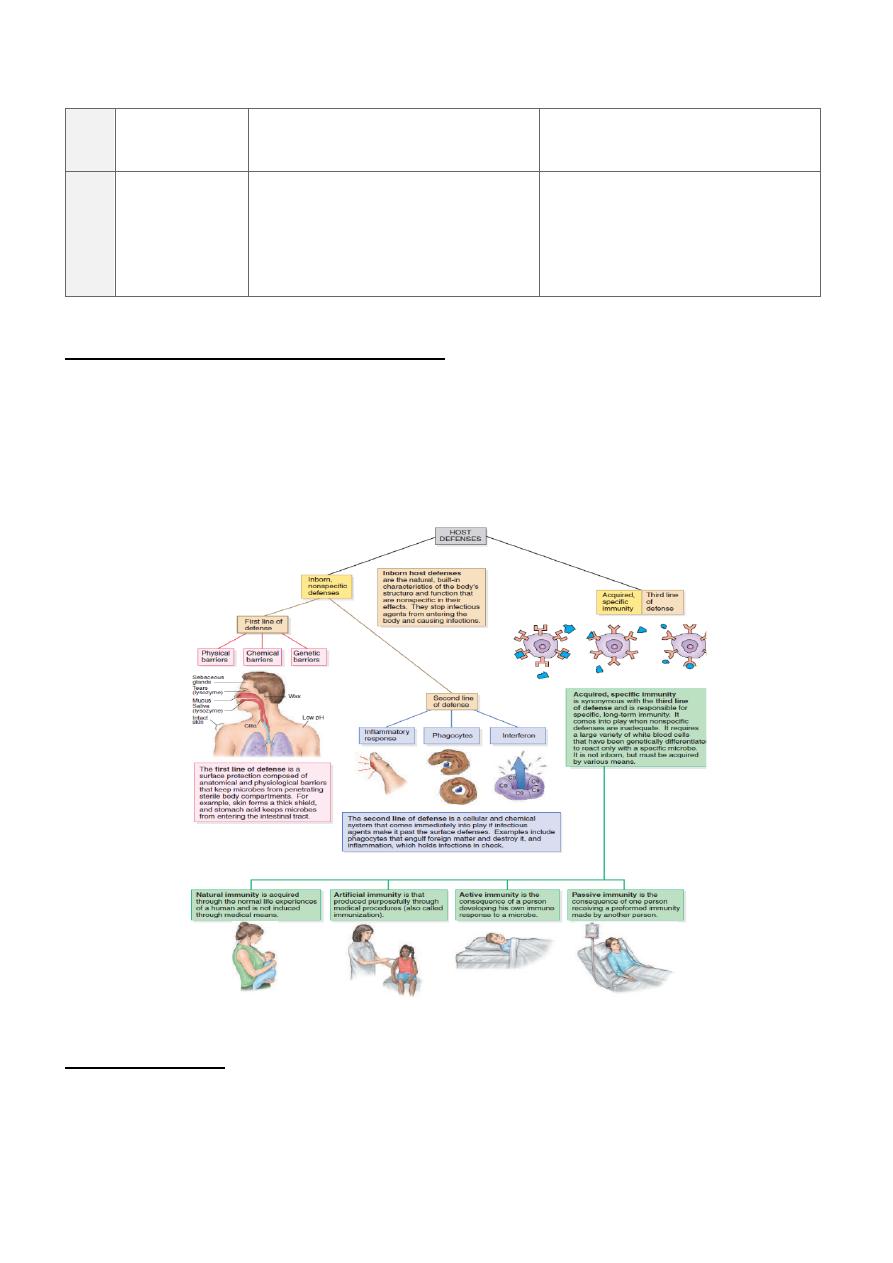
Lecture 1: The nature of host defense Dr Dhafer Alghezi
1
Introduction:
Immunology: is the study of all biological, chemical, and physical events surrounding the
function of the immune system (to react) against infectious microbes (bacteria- viruses-
fungi- parasites) and non-infectious foreign substances to eliminate them to protect the
body. The term immunity means the state of protection from infectious disease involving
specific and non-specific elements. The immune system is a complex collection of fluids
and cells that penetrate every organ, tissue space, fluid compartment, and vascular network
of the body.
Our environment contains a great variety of infections microbes. These can cause disease,
and if they multiply unchecked, they will eventually kill their host. So, the primary function
of the immune system is to eliminate infectious agents and to minimize the damage they
cause.
The protection of our organism against infectious agents involves many different
mechanisms: some nonspecific (i.e., generically applicable to many different pathogenic
organisms) and others specific (i.e., their protective effect is directed to one single
organism).
Immune response:
Any immune response involves, firstly, recognition of the pathogen or other foreign
material, and secondly a reaction to eliminate it. The different types of the immune
response fall into two categories:
Innate (non-specific) immune response which is the first line of defense against infection
and it does not alter on repeated exposure to a given infectious agent and it react in the
same manner with each pathogen.
Adaptive (specific) immune response: it is a highly specific for a particular pathogen and
the immune response improves with each successive encounter with the same antigen.
Thus, the two-key feature of the adaptive immune response are the specificity and the
memory.

Lecture 1: The nature of host defense Dr Dhafer Alghezi
2
The table below shows the main differences between innate and adaptive immune
responses.
N0. Characteristics
Innate Immunity
Adaptive immunity
1
Presence
Innate immunity is something already
present in the body.
Adaptive immunity is created in
response to exposure to a foreign
substance.
2
Specificity
Non-Specific
Specific
3
Response
Fights any foreign invader.
Fight only specific infection.
4
Response
Rapid
Slow (1-2 weeks)
5
Potency
Limited and Lower potency.
High potency
6
Time span
Once activated against a specific type
of antigen, the immunity remains
throughout the life.
The span of developed immunity can
be lifelong or short.
7
Inheritance
Innate type of immunity is generally
inherited from parents and passed to
offspring.
Adaptive immunity is not passed
from the parents to offspring; hence
it cannot be inherited.
8
Memory
Cannot react with equal potency upon
repeated exposure to the same
pathogen.
Adaptive system can remember the
specific pathogens which have
encountered before.
9
Presence
Present at birth
Develops during a person’s lifetime
and can be short-lived.
10
Used Against
For microbes
Microbes
and
non-microbial
substances called antigens
11
Memory
No memory
Long term memory
12
Complement
system
activation
Alternative and lectin pathways
Classical pathway
13
Anatomic and
physiological
barriers
Skin, Mucous membranes, Temp, pH,
chemicals, etc.
Lymph nodes, spleen, mucosal
associated lymphoid tissue.
14
Composition
The innate immune system is
composed of physical and chemical
barriers,
phagocytic
leukocytes,
Adaptive
immune
system
is
composed of B cells and T cells.

Lecture 1: The nature of host defense Dr Dhafer Alghezi
3
dendritic cells, natural killer cells, and
plasma proteins.
15
Example
White blood cells fighting bacteria,
causing redness and swelling, when
you have a cut.
Chickenpox vaccination so that we
don’t get chickenpox because
adaptive immunity system has
remembered the foreign body.
Defenses development and specificity
There are three lines of defenses against any foreign bodies: 1st line such as chemical,
physical and genetic barriers, second line defenses include phagocytosis, inflammation,
complement system, and interferon and third line defenses: acquired immunity.
First line defense:
The natural, inborn, nonspecific defenses that can be divided into physical, chemical, and
genetic barriers that impede the entry of microbes at the site of first contact.

Lecture 1: The nature of host defense Dr Dhafer Alghezi
4
Barriers at the Body’s Surface
In the skin
• (stratum corneum) of the skin is composed of epithelial cells that have become
compacted, cemented together, and impregnated with an insoluble protein, keratin.
• Sebaceous secretions exert an antimicrobial effect
• The high lactic acid and electrolyte concentrations of sweat and the skin’s acidic pH and
fatty acid content
Eye
• Blinking and (lacrimation) flush the eye’s surface with tears and rid it of irritants.
• Specialized glands such as the meibomian glands of the eyelids lubricate the
conjunctiva with an antimicrobial secretion (lysozyme)
• Lysozyme: an enzyme that hydrolyzes the peptidoglycan in the cell wall of bacteria.
The digestive tract
• The mucocutaneous membranes of the free surface of digestive tract, in addition to
saliva secretion (lysozyme) impedes the entry of bacteria
• The constant flow of saliva helps carry microbes into the harsh conditions of the
stomach.
• The HCl in the stomach renders protection against many pathogens that are swallowed.
• the intestine’s digestive juices and bile are potentially destructive to microbes.
• Vomiting and defecation also evacuate noxious substances or microorganisms from the
body.
Respiratory tract effective adaptations
• Nasal hair traps larger particles.
• Flushing action and copious flow of mucus and fluids that occurs in allergy and colds.
• The ciliated epithelium (called the ciliary escalator) in the respiratory tree a conveys
foreign particles entrapped in mucus toward the pharynx to be removed
• Irritation of the nasal passage reflexly initiates a sneeze, which expels a large volume of
air at high velocity.
• Similarly, the acute sensitivity of the bronchi, trachea, and larynx to foreign matter
triggers coughing, which ejects irritants.

Lecture 1: The nature of host defense Dr Dhafer Alghezi
5
The genitourinary tract
• The mucocutaneous membranes of the free surface of genitourinary tract
• periodic bladder emptying and continuous trickle of urine through the ureters that
flushes the urethra.
• Semen contains an antimicrobial chemical that inhibits bacteria, and the vagina has a
protective acidic pH maintained by normal flora.
Non-anatomical barriers
like resident flora by creating an unfavorable environment
for pathogens like pH in intestine and vagina.
Genetic Defenses
Some pathogens have great specificity to infect one host species that they are incapable of
infecting other species (e.g. Humans can’t acquire distemper from cats, and cats can’t get
mumps from humans). Genetic differences insusceptibility can also exist within members
of one species. Humans carrying a gene or genes for sickle-cell anemia are resistant to
malaria. why?
Q) Why the first line does not consider a true immune response?
because it does not involve recognition of a specific foreign substance but is very general
in action.
The importance of first line of defenses is manifested by examples:
1- Patients with severe skin damage due to burns are extremely susceptible to infections
2- With blockages in the salivary glands, tear ducts, intestine, and urinary tract are also at
greater risk for infection.
Q) Why the first line of defense alone is not sufficient to protect against infection?
Because many pathogens find a way to circumvent the barriers by using their virulence
factors.

Lecture 1: The nature of host defense Dr Dhafer Alghezi
6
Immune terminology
pathogen: an infectious agent that causes disease
Infectious disease: occurs when microorganism succeeds in evading host defenses to
establish a local site of infection and replication.
Foreign material: Is something that can be recognized or distinguished as not being a
natural part of an organism’s body
Surveillance: Is the process of scouting the tissues for foreign molecules and other
possibly threatening particles
Recognition: Is the process of evaluating and differentiating of the molecules that detect
by white blood cells surveillance.
Markers: Are molecules that protrude from the cell surface like minuscule signposts
announcing that cell or molecule’s identity.
Specificity: A unique configuration that dictates the kinds of immune responses it can
elicit.
Receptors: Molecules that bind specifically with complementary molecules in ways that
signal, communicate, and trigger reactions inside the cell.
Antigen: A foreign, non-self-molecule, often a surface marker, that evokes a specific
immune response.
